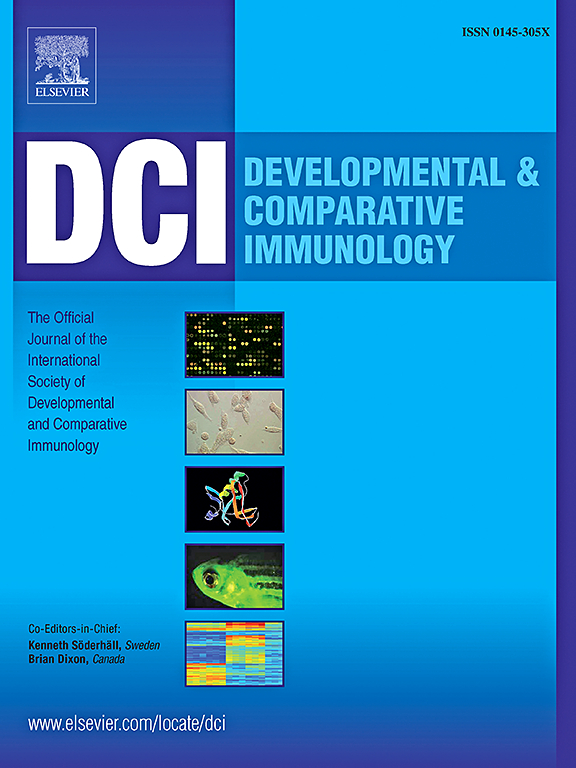Biphasic role of L-TGF-β2 in modulating lamprey inflammation: Insights into vertebrate immune evolution
IF 2.7
3区 农林科学
Q1 FISHERIES
引用次数: 0
Abstract
The regulation of inflammatory balance is central to immune homeostasis, with disruptions contributing to autoimmune diseases. As representatives of early vertebrates, lampreys offer a valuable model for investigating the evolutionary foundations of immune regulation. This study examines the dual role of L-TGF-β2 in modulating inflammation in lampreys, providing insights into the evolutionary origins of immune homeostasis mechanisms. Using lipopolysaccharide (LPS)-induced inflammation models, recombinant L-TGF-β2 was found to enhance leukocyte chemotaxis in quiescent states while inhibiting excessive migration during activation. Quantitative PCR revealed that L-TGF-β2 stimulates pro-inflammatory cytokine expression during early inflammatory phases and attenuates it during resolution. Tissue-specific expression patterns of TGF-β receptors indicated their potential role in mediating the distinct regulatory effects of L-TGF-β2 across diverse immune environments. These findings align with the biphasic functions of TGF-β observed in higher vertebrates, underscoring the evolutionary conservation of this signaling pathway. This research enhances understanding the functional versatility of TGF-β signaling and its pivotal role in vertebrate immune evolution, providing insights into ancient mechanisms of immune homeostasis and their modern implications for inflammatory disease research.
L-TGF-β2在调节七鳃鳗炎症中的双相作用:对脊椎动物免疫进化的见解
炎症平衡的调节是免疫稳态的核心,其破坏会导致自身免疫性疾病。作为早期脊椎动物的代表,七鳃鳗为研究免疫调节的进化基础提供了一个有价值的模型。本研究探讨了L-TGF-β2在调节七鳃鳗炎症中的双重作用,为免疫稳态机制的进化起源提供了新的见解。利用脂多糖(LPS)诱导的炎症模型,发现重组L-TGF-β2在静止状态下增强白细胞趋化性,同时抑制激活过程中的过度迁移。定量PCR结果显示,L-TGF-β2在炎症早期刺激促炎细胞因子的表达,在消退过程中减弱促炎细胞因子的表达。TGF-β受体的组织特异性表达模式表明其在介导L-TGF-β2在不同免疫环境中的不同调节作用中的潜在作用。这些发现与在高等脊椎动物中观察到的TGF-β的双相功能一致,强调了该信号通路的进化保守性。本研究增强了对TGF-β信号的功能多样性及其在脊椎动物免疫进化中的关键作用的理解,为免疫稳态的古老机制及其对炎症疾病研究的现代意义提供了见解。
本文章由计算机程序翻译,如有差异,请以英文原文为准。
求助全文
约1分钟内获得全文
求助全文
来源期刊
CiteScore
6.20
自引率
6.90%
发文量
206
审稿时长
49 days
期刊介绍:
Developmental and Comparative Immunology (DCI) is an international journal that publishes articles describing original research in all areas of immunology, including comparative aspects of immunity and the evolution and development of the immune system. Manuscripts describing studies of immune systems in both vertebrates and invertebrates are welcome. All levels of immunological investigations are appropriate: organismal, cellular, biochemical and molecular genetics, extending to such fields as aging of the immune system, interaction between the immune and neuroendocrine system and intestinal immunity.

 求助内容:
求助内容: 应助结果提醒方式:
应助结果提醒方式:


